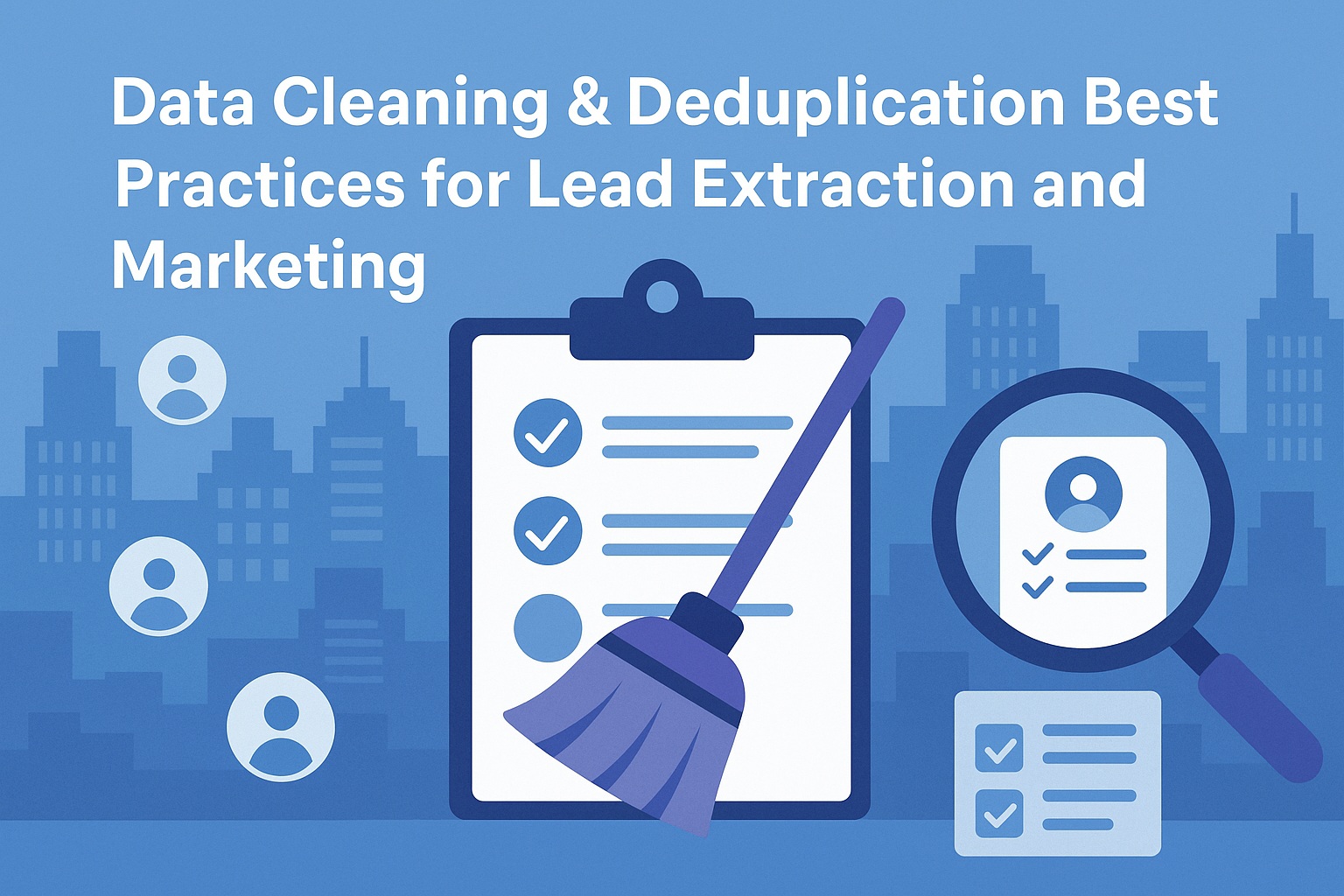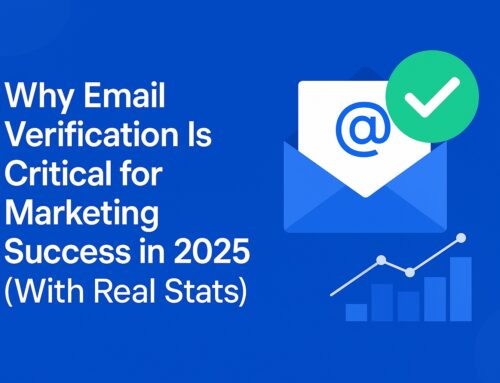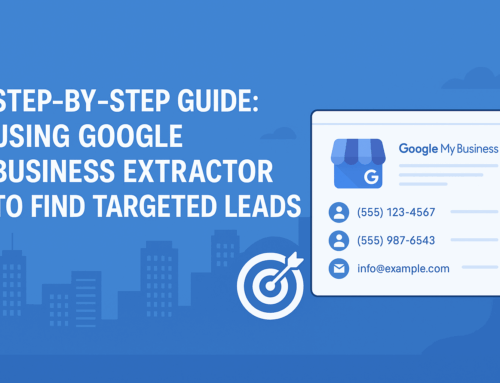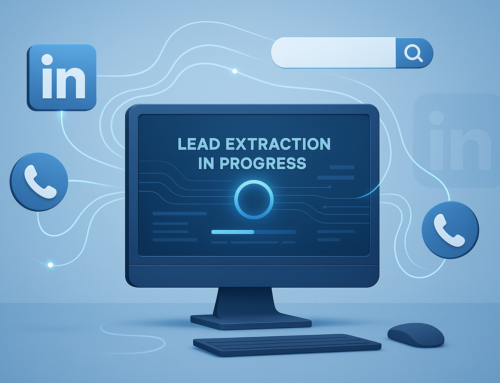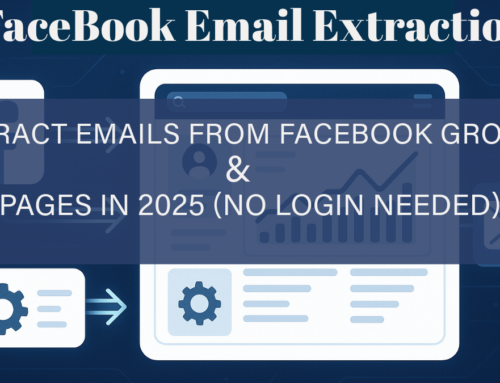Introduction
In the world of digital marketing and lead generation, data is your currency. But just like real currency, its value depends on its purity.
Even the most powerful data extraction or lead generation tools can produce messy, duplicated, or outdated data if you don’t maintain it properly.
Unclean data leads to inefficient campaigns, wasted time, and poor ROI. Imagine sending the same marketing email twice to one person, or calling a prospect who no longer works at that company — that’s not just unprofessional, it hurts your brand credibility.
That’s why data cleaning and deduplication should be part of every marketer’s or business owner’s workflow.
In this guide, we’ll cover:
-
What data cleaning and deduplication mean
-
Why they’re essential
-
Common problems with unclean data
-
Step-by-step cleaning process
-
Best practices and tools to automate it
Let’s get started.
What Is Data Cleaning?
Data cleaning is the process of identifying and fixing errors, inconsistencies, and inaccuracies in your data set.
In the context of lead extraction, this means improving the quality of data you’ve scraped or imported from various sources — such as Google Business, social media, or email lists.
Typical cleaning tasks include:
-
Removing duplicates
-
Correcting misspelled names or domains
-
Formatting phone numbers and emails consistently
-
Filling in missing details
-
Verifying contact information (email and phone validation)
In short, it’s how you turn raw scraped data into a reliable, actionable database.
What Is Deduplication?
Deduplication (or “de-dupe”) is a key part of data cleaning that involves identifying and removing duplicate records.
Duplicates happen when:
-
The same lead is extracted multiple times from different sources
-
Multiple entries have minor spelling differences
-
Merged datasets overlap (e.g., CRM + new scraper results)
For example:
| Name | Phone | |
|---|---|---|
| John Smith | john@abc.com | 9876543210 |
| J. Smith | john@abc.com | 9876543210 |
These are duplicates even if the names are slightly different. Deduplication removes such redundancies, leaving one clean, accurate record.
Why Clean & Deduplicate Data?
Here’s why every business that uses lead extraction software should clean data regularly:
1. Better Marketing Performance
Clean data ensures your email and SMS campaigns reach the right people. No bounces, no duplicates, no wasted effort.
2. Saves Time and Money
Invalid or duplicated data increases campaign costs (you pay per contact in most platforms). Cleaning data reduces expenses.
3. Improves Conversion Rates
Accurate data = better personalization = higher engagement and conversions.
4. Prevents Brand Damage
Sending duplicate emails or contacting the wrong person damages your brand image.
5. Supports Compliance
GDPR, CAN-SPAM, and other privacy regulations require accurate, consent-based data. Cleaning ensures compliance.
Common Issues Found in Scraped Data
When you use a lead extraction tool (like RedScraper’s Google Business Extractor or Social Media Extractor), the following issues often occur in raw output:
| Problem | Example | Fix |
|---|---|---|
| Duplicate records | Same lead from multiple sources | Deduplication rules (by email, phone, company) |
| Invalid emails | test@test or missing “.com” | Use bulk email verification tool |
| Wrong phone formats | +91-98765 43210 / (0987)654321 | Standardize formats |
| Missing data | Blank name or company fields | Use enrichment tools |
| Inconsistent capitalization | “red scraper”, “RedScraper” | Apply text normalization |
| Dead domains | abc@company123.com (no longer exists) | Verify domain existence |
Step-by-Step: How to Clean and Deduplicate Extracted Data
Here’s a simple workflow you can apply whether you’re cleaning 500 or 50,000 leads.
Step 1: Gather and Consolidate Your Data
-
Export your leads from all possible sources: Google Business, Outlook Extractor, Social Media Extractor, etc.
-
Combine them into a single master sheet (Excel, Google Sheets, or CSV).
-
Create a “Raw Data” backup so you can restore if needed.
Step 2: Standardize Data Formats
To avoid mismatched entries, ensure all fields follow a uniform format:
| Field | Standard Format | Example |
|---|---|---|
| Name | Title Case | John Smith |
| Lowercase | john@abc.com | |
| Phone | Numeric, country code | +1 2025550100 |
| Company | Title Case | RedScraper Pvt. Ltd. |
| Website | lowercase, no “http://” | redscraper.com |
Most spreadsheet tools allow simple Find & Replace or LOWER(), UPPER(), PROPER() formulas to standardize text.
Step 3: Remove Exact Duplicates
In Excel or Google Sheets:
-
Select all data.
-
Go to Data → Remove Duplicates.
-
Choose the identifying columns (usually email, phone, or both).
For advanced cleaning, use tools like:
-
OpenRefine (free)
-
Deduply (for HubSpot/CRM users)
-
Zapier Formatter + Google Sheets integration
Step 4: Identify Fuzzy Duplicates
Sometimes duplicates aren’t exact matches — e.g.,
For these cases, use fuzzy matching tools such as:
-
Excel’s
Fuzzy Lookup Add-In -
Python libraries (
fuzzywuzzy,pandas) -
Cloud tools like Talon.One Deduplicate or Data Ladder
Set similarity thresholds (e.g., 90%) to find near-duplicates.
Step 5: Verify Email Addresses
Even if emails look valid, they might bounce.
Use an email verification tool (like RedScraper’s Bulk Email Verifier) to check deliverability.
It will:
✅ Remove syntax errors
✅ Check MX records
✅ Detect temporary or disposable addresses
✅ Mark invalid or risky emails
Step 6: Validate Phone Numbers
Normalize international phone formats using tools like:
-
Google’s libphonenumber library
-
Phone validator APIs
Ensure the numbers include country codes and are SMS/call deliverable.
Step 7: Remove Unwanted or Irrelevant Leads
Sometimes scrapers collect irrelevant categories.
For example, if you’re targeting marketing agencies, remove unrelated businesses like cafés or gyms.
Apply filters:
-
By business category
-
By website domain
-
By region or rating
Step 8: Append / Enrich Missing Data
If key fields like email or company name are missing, enrich the data using:
-
LinkedIn search
-
Hunter.io or Apollo.io
-
Built-in enrichment features of scraping tools
Step 9: Recheck for Duplicates After Cleaning
After all transformations, run one final deduplication pass before saving the cleaned dataset.
Step 10: Automate Future Cleaning
Once you set your cleaning rules, automate the process with:
-
Zapier (trigger after new extraction)
-
Google Sheets scripts
-
CRM automation (HubSpot workflows, Salesforce dedupe rules)
Automation ensures every new batch of data stays clean without manual effort.
Best Practices for Maintaining Data Quality
-
Clean Before Importing:
Don’t upload raw data into your CRM — clean first. -
Use Consistent Field Names:
Keep naming conventions consistent (e.g., “Email” not “E-mail” or “email_address”). -
Schedule Monthly Cleaning:
Data decays at 20–30% per year. Regular cleaning prevents buildup of bad data. -
Set Validation Rules:
In CRMs, restrict incorrect entries — e.g., require “@” in emails, numeric-only phones. -
Centralize Your Database:
Avoid having leads spread across Excel files, CRM, and email lists. One unified database = easier deduplication. -
Track Data Sources:
Add a “Source” column (Google Extractor, Outlook Extractor, etc.) to understand where your best leads come from. -
Leverage Built-In Cleaning Features:
If you’re using RedScraper, most tools allow exporting “cleaned” results directly, minimizing post-processing work.
Tools You Can Use for Cleaning and Deduplication
| Tool | Use Case | Highlights |
|---|---|---|
| RedScraper Email Verifier | Email list validation | Unlimited verification, accurate results |
| OpenRefine | General data cleaning | Free & powerful for large datasets |
| Deduply | CRM deduplication | Works with HubSpot, Salesforce |
| Google Sheets / Excel | Quick cleanup | Easy formulas & filters |
| Zapier Formatter | Automation | Auto-format new leads |
| Python Scripts | Custom cleaning | Fuzzy match, rule-based filtering |
Benefits of Clean, Deduplicated Data
-
Increases Campaign ROI: Better data → better targeting → more conversions.
-
Improves CRM Efficiency: No wasted space or duplicate entries.
-
Enhances Reputation: No spam complaints or duplicate outreach.
-
Faster Analysis: Accurate reports and segmentation.
-
Compliance Ready: Meets GDPR / CAN-SPAM requirements.
Conclusion
Data cleaning and deduplication are not “nice to have” — they’re non-negotiable.
In the lead generation cycle, extraction is just the first step. The real value comes when your data is accurate, unique, and ready for personalized outreach.
By adopting these best practices, you’ll save hours of manual work, improve your marketing results, and ensure your brand always communicates with precision.
✅ Next Steps
-
Run your latest extracted data through your cleaning checklist.
-
Use a bulk email verifier and deduplication tool.
-
Automate cleaning rules for every future data extraction job.
👉 Ready to take your lead data quality to the next level?
Try RedScraper’s suite of tools — from Google Business Extractor to Bulk Email Verifier — and turn raw data into high-converting leads today.

